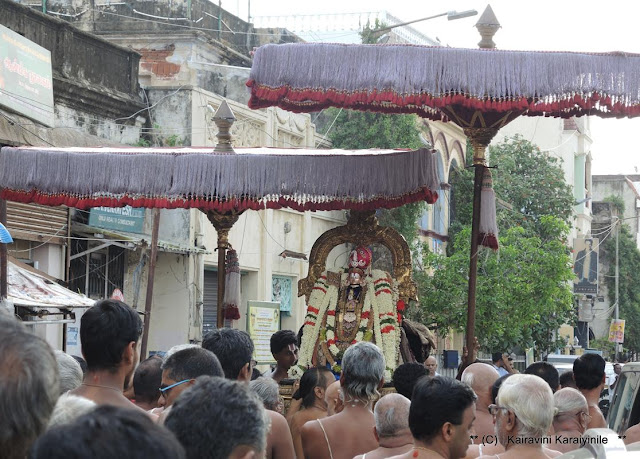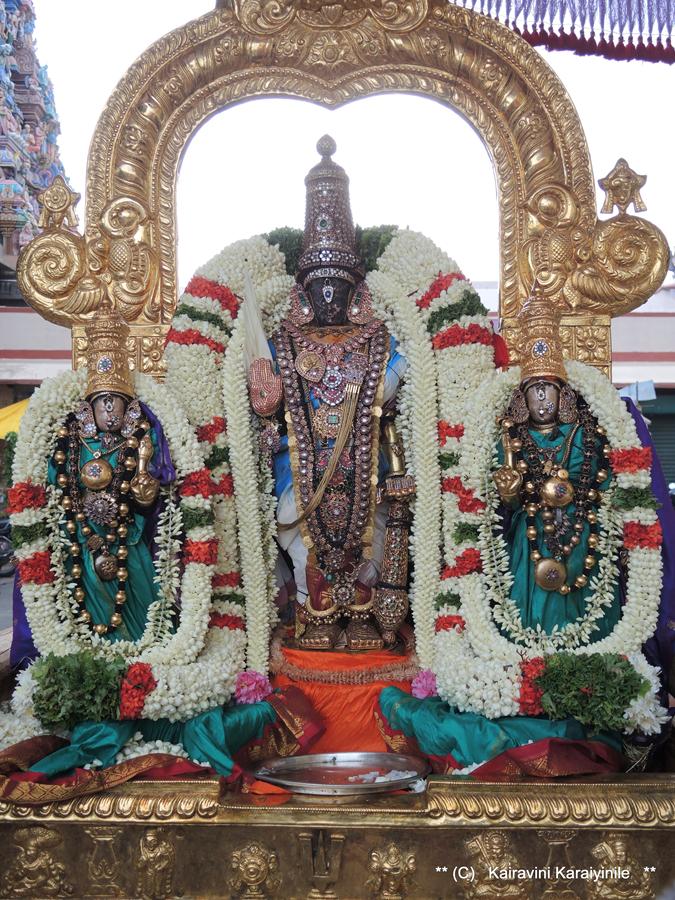Ascending Thirumala by foot
and worshipping Lord Srinivaasa
For a Srivaishnavaite - visiting Divyadesams
and having darshan of Emperumans in these places are of utmost
importance. When we utter – “Kovil,
Thirumalai, Perumal Kovil “- reference is
to “Thiruvarangam, Thirumala Tirupathi and
Kanchipuram”respectively.
The sacred and most reverred temple of Sri Venkateswara is
located on the seventh peak – Venkatachala hill of Tirumala. The Lord
stands tall as bestower of all boons and lakhs of people reach here to have a
glimpse – a few seconds darshan of the Lord. This beautiful temple in its
present form owes a lot to the works of the greatest Vaishnava Acharya – Sri Ramanujar.
“Adi vo Alladi Vo Sri Hari Vasamu…. Padi Velu Seshula Padagala
Mayamu” … Look and behold, this is
abode of Hari- the place where He resides, formed by the hood of Adisesha;
place where sages dwell uttering His name all the time; the place replete with
riches and prosperity, the Holiest of all places …. sang Tallapaka Annamacharya
[popularly Annamayya], the 15th century musician who composed
keerthanas on Lord Venkateswara.

The sacred Thirumala, the abode of Lord Venkataramana, [Balaji,
Govinda, Ezhumalaiyan….] starts with Alipiri, the place at foothill of
seven hills in Tirupathi, from where pilgrims starts ascending the Holy
Thirumala. Alipiri literally would mean resting place. In olden days pilgrims
used to climb all the seven hills only through the stepped way on foot, as
there was no other option. The pilgrims coming from long distances
used to take rest for some time at the starting place **Alipiri** [adivaram in
Tamil] cooked their food, eat, hailed the benevolence of the Lord and after rest, with
sacredness imbued in their hearts, started climbing the steps.
Times have changed – presently there are lots of facilities in
the hill; [the commitment and bakthi of pilgrims is ever on the increase] the roads are very well laid. The
transportation is at its best as there are buses at almost every 5 minutes from
the foothill to the top – the abode of Lord. Private vehicles too are allowed
~and there are so many new cars, motor cycles, jeeps and other vehicles.
In olden days, people used to climb the hill afoot which was arduous. Sri
Udayavar (Ramanujacharya) used to climb the hill on his knees reverring the
sacredness of the hill itself. The starting point Alipiri is around
5 km from the Railway Station / Bus stand and the temple of Sri Govindarajar at
Tirupathi.
The Seven hills have thick vegetation and some animals too.
Once in a while some wild animals are spotted. A few decades ago, there
were lot of monkeys abounding the holy hills – [I thought them to be common bonnet macaque; they were caught
and taken out of Thirumala; this time I spotted some, which looked like Gray
langurs or Hanuman langurs, more hostile than the macaque
!]…….. What was
thick vegetation and foothill of a forest has in the recent decade been
converted– to a spacious hub where vehicles and persons undergo ‘security
check-up’. The transformation at
this place in someways owes to that ghastly incident in Oct 2003, when the
then CM of Andhra Pradesh N. Chandrababu Naidu, survived an attempt on
his life when suspected People's War naxalites exploded improvised claymore
mines targeting his motorcade on the Tirumala ghat road. Mr Naidu
suffered some injuries – the impact of the blast was so severe that the
bullet-proof car was hurled in the air. A major bloodshed was averted because
the car could absorb the impact of the powerful blast.……. Years later a
Tirupati court on Thursday sentenced three persons -- accused in the Alipiri
blast case to undergo rigorous imprisonment for four years and to pay fine of
Rs. 5,000 each. Of the 33 accused in the case registered in Alipiri
police station in 2003, 11 died during trial and 15 were still at large.


There are now 3550 steps [a distance of
around 11 – 12 km] and for a healthy
person would take around 4 to 4.5 hours
to climb the hill. The footsteps in most
places are well covered and there are shops along the way selling beverages,
fruits, biscuits and the like. Tirumala Temple Devasthanam [TTD] has made elaborate arrangements including care of the
luggage of the devotees who ascend the hill on foot. The baggage deposited at Alipiri is carried free
of cost and can be collected at the top. The bags should have a lock is a pre-requisite.
They also issue tokens facilitating special darshan for the pilgrims,
which is revalidated at another point.
On the way stands a deer park housing hundreds of deers, which attracts people. At every point enroute, you can see thousands of
people climbing the hill by foot – the pilgrims include children, youth, old
people and those with some disabilities – all with full faith on Lord Srinivasa, climbing happily singing paeans in praise of
the Lord and speaking of the greatness of the Lord.
At the starting point, a huge statute of Garuda azhwar
stands. There is Raja gopuram, Mysore gopuram, Gali gopuram, tall statute
of Prasanna Aanjaneya, steep steps known as Mokali mitta (literally
breaker of knees). On the way, TTD has installed statues describing the
Dasavatharam – 10 avatars of Lord as also that of Azhwars who have sung about
the divyasthalam. Near the Mokali mitta stands a temple of our
Ramanuja charya. It is a holy place for all ~ as it was here our
Jagadacharya Udayavar took rest when he was climbing the hill on his knees.











Here are some photos taken recently when I had the great fortune
of climbing the divine hill by foot. In fact there is another path too –
besides Alipiri, there is another known as Srivari Mettu, nearer Srinivasa
Mangapuram in Chandragiri mandal. It is believed that Srivarimettu is
much older pedestrian path, believed to have been used by legendary emperor Sri
Krishna devaraya in 16th century. This path stands
revived in a decade or so. This reportedly is shorter route and Thirumala
can be reached in less than 3 hours. The facilities on this route are perhaps
less and there are time restrictions in using this path. While there are
frequent free buses of TTD to Alipiri, it much less to
Srivarimettu, which passes through dense forest that has some animals.
Adiyen Srinivasa dhasan.
****************************************************************************************
ஸ்ரீ
வைஷ்ணவர்களுக்கு "திருமலை" என்றால் திருவேங்கடமுடையான் உறையும்
திருவேங்கடம் என்பதுவே !.... திருமங்கை ஆழ்வார் தமது
திருமொழியில் :
பேசுமின்
திருநாமம் எட்டெழுத்தும் சொல்லி நின்று பின்னரும்
பேசுவார்
தம்மை உய்ய வாங்கிப் பிறப்பு அறுக்கும் பிரானிடம்
வாசமாமலர்
நாறுவார் பொழில் சூழ்தரும் உலகுக்கு எல்லாம்
தேசமாய்
திகழும் மலைத் திருவேங்கடம் அடை நெஞ்சமே. *** –
என்று
திருமலைக்கு சென்று உய்வு அடையுமாறு வழி காட்டுகிறார்.
'கலியுகத்தில்
கண் கண்ட தெய்வமான திருவேங்கடமுடையானின் திவ்யதேசம், அருள்கள் அனைத்தையும் தரும் சிறந்த இடமாய் திகழ்கிறது.
மழையோ, வெயிலோ, குளிரோ பாராமல் இங்கே குவியும் பக்தகோடிகள் எம்பெருமானின் சில வினாடி
தர்சனம் பெற ஓடோடி வருகிறார்கள். திருப்பதி என்பது மலைக்கு கீழே உள்ள பகுதியையும்
திருமலா என்பது திவ்யமான திருமலையையும் குறிப்பதாக கொள்ளலாம். இந்த திவ்ய
தேசம் ஏழு மலைகளுக்கு நடுவே சிறப்புற மிளிர்கிறது.
"ஸ்ரீ
சேஷசைல கருடாசல வேங்கடாத்ரி நாராயணாத்ரி வ்ருஷபாத்ரி வ்ருஷாத்ரி முக்யாம்" என
பாடப்படும் திருமலையில் உள்ள மலைகள் : சேஷாத்ரி, நீலாத்ரி, கருடாத்ரி, அஞ்சனாத்ரி,
வ்ருஷபாத்ரி, நாராயணாத்ரி, வேங்கடாத்ரி என ஏழு
சிகரங்கள்.
“சென்றுசேர்
திருவேங்கட மாமலை, ஒன்றுமே தொழ நம் வினை ஒயுமே!: - திருவேங்கடவனை காண திருமலை
நடந்து ஏறி சென்று தரிசனம் செய்தல் மிக புண்ணியம். சுமார் ஐம்பது
வருடங்கள் முன்பு கூட திருமலைக்கு செல்வது சற்று கடினமானதாகவே இருந்து வந்தது. அந்நாட்களில்
பஸ் வசதி குறைவு. மேலும் ஏறிச் செல்வதற்கும் இறங்குவதற்கும் ஒரே வழிதான். இன்றைய
நிலைமை வேறு. மிக எளிதாக பல வாகனங்கள் செல்கின்றன. சில வருடங்கள் முன்பு வரை, திருமலையில்,
கோவில் அருகே பல மடங்களும் தங்கும் விடுதிகளும் இருந்தன. இப்போது அவை அங்கு இருந்த
தடயம் கூட இல்லை. இந்த நூற்றாண்டு ஆரம்பத்தில் கூட ஒரு தடவை, நாங்கள் கோவில் வாசல்
மிக அருகே கற்பூரம் ஏற்றும் ஸ்தம்பம் முன்பு இருந்த விடுதில் தங்கி உள்ளோம்.
அப்போது மேடாக இருந்த இடமெல்லாம் கூட துடைத்தாற்போல் கட்டிடங்கள் இருந்த சுவடே
இல்லமால் மாறி உள்ளன.
திருமலை
அவ்வளவு இயற்கை அழகும், வளமும் கொண்ட ஒரு அற்புத பிரதேசம். அடர்த்தியான வனம் - அங்குள்ள
மரங்களும், மலை அமைப்பும், ஆங்கங்கே சல சலவென பிரவகிக்கும் அருவிகளும் ரம்மியமானவை.
முன்பு மிக கடினமாக இருந்த மலைபாதை இப்போது சுலபமாக பல வசதிகளுடன் அமைக்கப்பட்டுள்ளது.
அலிபிரி எனும் மலை அடிவாரத்தில் கருடாழ்வார் பிரம்மாண்டமாய் நிற்கும் இடத்தில்
இருந்து திருமலையை அடைய சுமார் 3550 படிகள் ஏற வேண்டும். பலவிதமான
பக்தர்கள் - வெவ்வேறு ஊர்களில் இருந்து வருபவர்கள், குழந்தைகள் முதல் முதியோர் வரை
பல பிராயத்தினர் வேங்கடவனை காண வேண்டி நடந்து வருகின்றனர். சாதரணமாக நான்கு முதல் ஐந்து
மணி நேரங்களில் மலை ஏற இயலும். - ஆழ்ந்த பக்தியும், அசைக்கமுடியாத நம்பிக்கையும்,
அவனை அடைவதில் அளப்பில்லா ஆர்வமும் கொப்பளிக்க பக்தர்கள் பாடிக்கொண்டும், அவனது அற்புதங்களை
பேசிக்கொண்டும் திருமலை ஏறுகின்றனர்.








அலிபிரி
அருகே தேவஸ்தானம் அலுவலகம் உள்ளது. இங்கே பக்தர்கள் தங்கள் இடம் உள்ள மூட்டைகளை
ஒப்படைத்து விட்டு கஷ்டமில்லாமல் மலை ஏறலாம். பல ஊர்களில் இருந்து
பன்மொழி பேசுவோர் மலை ஏறுகின்றனர். திருவேங்கடவனின் பாடல்களைப்
பாடிக்கொண்டும், தீதில் சீர் திருவேங்கடத்தானின் திருவிளயாடல் புராணங்களை சொல்லிக்
கொண்டும் அவனை மட்டுமே நினைத்து, அவன் புகழ் பாடி அவனருள் வேண்டி நெஞ்சுருக ஆயிரக்கணக்கானோர்
மலை ஏறுகின்றனர்.
**பண்டெல்லாம்
வேங்கடம்** என ஆழ்வார் பாடிய இத்திருக்கோவில் ஏறும் வழியில் சரித்திர நிகழ்வுகளும்,
அவற்றை விளக்கும் பெயர் பலகைகளும் உள்ளன. ஏறும் வழியில் - கருடாழ்வார், ராஜ கோபுரம்,
மைசூர் கோபுரம், காலி கோபுரம், விஸ்வரூப பிரசன்ன ஆஞ்சநேயர், விஷ்ணு பாதம், முழங்கால்
முறிச்சான் என பல இடங்கள் உள்ளன. அழகான மான்கள் பூங்கா உள்ளது. குரங்கு, காட்டு
அணில், மயில், பல விதமான விலங்குகள் காணும் வாய்ப்பும் உள்ளது பல கடைகள் உள்ளன. ஒன்றிரண்டு
இடங்களில் நடக்கும் பாதை இறங்கி வரும் பஸ் பாதையில் அமைந்து உள்ளதையும் காணலாம்.
தசவாதார
சிலைகள் அழகாக உள்ளன. மேலும், திருமலை பெருமாளை மங்களாசாசனம் செய்த ஆழ்வார்களின்
சிலைகளும் - அவர்கள் பற்றிய குறிப்புகளும் உள்ளன. சுமார் 2900 படிகள் ஏறியதும்
முழங்கால் முறித்தான் என்ற இடம் உள்ளது. நமது
ஒப்பாரிலாத இராமானுஜர் திருமலையை தமது முழங்கால்கள் தவழ ஏறி வந்து, இவ்விடத்தில் இளைப்பாறியதால்
இப்படி பெயர் சிறப்பு பெற்றது இவ்விடம். இங்கே உடையவருக்கு விஜய மன்னர்கள் காலத்தில்
கட்டப்பட்ட கோவில் ஒன்று உள்ளது.
இப்போது
நடந்து வரும் பக்தர்கள் திருவேங்கடமுடையனை தரிசிக்க சிறப்பு ஏற்பாடுகள் செய்யப்பட்டு
உள்ளதால் அவர்கள் தனி வரிசையில் பெருமாளை சேவிக்க இயல்கிறது.
விநா
வேங்கடேசம் ந நாதோ ந நாத ; சதா வேங்கடேசம் ஸ்மராமி ஸ்மராமி
ஹரே
வேங்கடேச ப்ரசீத ப்ரசீத ப்ரியம் வேங்கடேச ப்ரயச்ச ப்ரயச்ச :
வேங்கடேசனைத்
தவிர வேறு தலைவன் இல்லை! வேறு தலைவன் இல்லை! எப்போதும் வேங்கடேசனையே
நினைத்துக் கொண்டிருக்கிறேன்! நினைத்துக் கொண்டிருக்கிறேன்!
நிகரில்
அமரர் முனிக்கணங்கள் விரும்பும் திருவேங்கடத்தானை அடைந்தார்க்கு எல்லா சிறப்பும் கிடைக்கும்
என்பது திண்ணம்.
அடியேன்
- ஸ்ரீனிவாச தாசன்.
5th
Mar 2017
[ Ascending Thirumala from alipiri is
no post for those who have walked entirely from Chennai and other far off
places; my regards to them and let them excuse me for this post describing in
some detail – the walk from alipiri ]
[the writing is almost a repost of my earlier visit ~ photos are new !]

































































